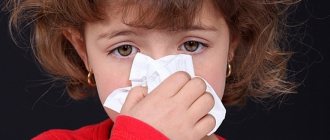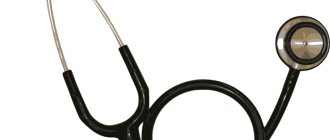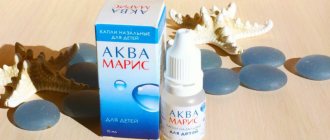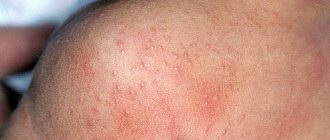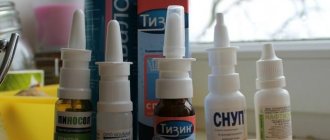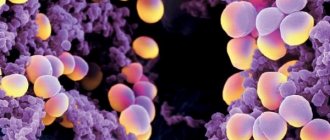A runny nose is almost never an independent disease, so prevention of rhinitis should consist of treating the underlying disease. Rhinitis is an unpleasant condition that greatly interferes with a person’s normal life. It is not recommended to leave a runny nose unattended, as it can provoke the progression of the underlying disease or become an impetus for the development of new pathologies. To understand exactly how the runny nose should be prevented in children and adults, you need to know what causes it can occur. In addition, rhinitis can have a different course, and preventive measures will be different.
Prevention of runny nose in children and adults
A runny nose, rhinitis or inflammation of the nasal mucosa is manifested by the presence of nasal discharge and congestion, which occurs as a manifestation of respiratory viral diseases or acute respiratory infections (colds).
During periods of exacerbation of colds and seasonal (autumn-spring) epidemiological outbreaks (influenza and ARVI), articles on the treatment of the runny nose are more in demand, but the topic of prevention is no less important for both adult patients and children of any age. After all, as you know, preventing the development of a runny nose is much more important than treating it.
But in order to begin preventing a runny nose, it is necessary to understand the causes of its occurrence: to prevent the causative factor and the mechanisms of its development in advance.
Prevention of runny nose in children
Many parents mistakenly believe that a runny nose is not a disease and does not require treatment, much less prevention. In the old days, it was even believed that a “snotty” baby meant a healthy one, and all these manifestations went away as the child grew. Perhaps they were right in some ways - at one time, but not now.
A runny nose is a common or everyday name for the main inflammatory process that develops in the mucous membrane of the nasal cavity (in medicine this term is called rhinitis). At the same time, a runny nose is considered a protective reaction of the body to the entry of pathogenic agents into the body and the first symptom of various respiratory diseases that are caused by viruses, pathogenic or opportunistic bacteria, fungi or their associations (a combination of several pathogens), with the nasal passages being the entry point for infection .
Abundant watery mucous discharge from the nose, inflammation of the mucous membrane and its swelling are nothing more than the need to get rid of foreign agents that have become fixed on the mucous membrane. With good immunological reactivity of the body, the absence of background pathologies, allergic reactions, a healthy diet and lifestyle, high physical activity and the body’s resistance to stress factors, rhinitis goes away on its own in 5-7 days.
But today, not a single child has a complete set of all the necessary parameters, especially good immunity from birth. On the contrary, from year to year, babies are born with a weakened immune system, congenital pathologies that are provoked by an abnormal pregnancy, and a high risk of developing allergic reactions (against the background of an unfavorable environment and underdevelopment of the allergic system). This often leads to a complicated course of all diseases, including a common runny nose, which at the same time serves as the first symptom of a respiratory infection.
After all, it is the manifestations of rhinitis: sneezing, congestion and thin mucous discharge from the nose that are considered the first sign of acute respiratory viral infections or acute respiratory infections, which, if treated incorrectly or untimely, can transform into laryngitis, sore throat, bronchitis, pneumonia, alveolitis.
Rhinitis can also be complicated by otitis media, sinusitis (ethmoiditis, sinusitis or frontal sinusitis), and also become chronic.
In addition, impaired nasal breathing and mucus constantly flowing from the nose causes physical and everyday inconvenience to the child:
- For infants and young children, a runny nose prevents them from sleeping and eating, they experience anxiety and regurgitation, which only aggravates the course of the disease;
- Older children experience oxygen starvation of all cells, primarily the brain, which affects the child’s learning and behavior.
There is always a danger of developing otitis (the more often the baby has episodes of runny nose, the higher the risk of developing tubotitis and even mastoiditis, which can only be treated surgically), sinusitis, or the systematic descent of the infection into the lower respiratory tract, due to the flow of infected mucus down the back wall of the pharynx.
Therefore, timely treatment of a runny nose and proper prevention of this unpleasant phenomenon can save a child from repeated and frequent diseases of rhinitis.
The main preventive measures for runny nose in children include:
Strengthening the baby’s immunity, which must be done from birth
The first thing parents need to know when it comes to improving their baby’s immunological reactivity is a constant flow of fresh air and creating a comfortable microclimate in the house.
The temperature in the room should not be higher than 22-23 C, the air should be humidified, which is created by periodic ventilation, wet cleaning or the use of special devices (humidifiers) if necessary.
You need to often walk with the baby, dressing the baby according to the weather (constant wrapping and dressing only aggravate the decrease in the adaptive properties of the immune system and activate the load on the thermoregulation system).
The baby's nutrition is also important - long-term breastfeeding promotes the natural maturation of the immune system, activation of its adaptive properties, reducing the load on the baby's digestive system and additional exposure to the mother's protective agents. The correct introduction of complementary foods is also important - timely expansion of the baby’s menu, reducing allergenicity in the body, and a balanced introduction of vitamins and minerals.
Hardening techniques are also an important factor - rubbing with cool water (with a gradual decrease in temperature over a long time), foot baths, baths with decoctions of medicinal herbs, sun and air baths, climatotherapy.
Healthy lifestyle
Stimulation of the immune system and its maturation as the child grows in most cases directly depends on his physical activity, long stays in the fresh air, sports and a healthy diet (complete and balanced), daily routine, healthy sleep throughout all age periods of the child;
Treatment of concomitant pathologies, underlying conditions and foci of chronic infections
Often, any problem in the child’s body leads to the development of pathological conditions; parents need to pay special attention to the presence of diathesis, dysmetabolic nephropathy, biliary dyskinesia, caries, adenoid growths, chronic tonsillitis, pathology of the immune status, endocrinopathies, constipation. Often functional disorders develop into somatic diseases, which significantly reduce the body's resistance to the effects of aggressive agents;
Avoid hypothermia and contact with the source of infection
In most cases, acute respiratory infections and acute respiratory viral infections are caused by hypothermia or close contact with sick people, and teach your child to follow the basic rules of hygiene and sanitation:
- wash your hands after coming from the street;
- do not rub your eyes with dirty hands or put them in your mouth or nose, do not use other people’s handkerchiefs or napkins.
Prevention of runny nose in adults
In case of frequent episodes of colds and to prevent them, it is necessary to take preventive measures in a timely manner.
To do this, you need to know the main reasons for the development of colds.
These include:
1) the first place among the main causes of colds is occupied by pathogenic microorganisms, less often fungal flora.
In most cases, bacteria are permanent inhabitants of the nasopharynx or paranasal sinuses, which are activated in the nasopharynx when favorable conditions arise:
- hypothermia;
- stress;
- persistent decrease in the body’s immunological reactivity;
- layering of viral infection.
2) in second place are allergic reactions in the form of rhinitis and rhinosinusitis, which arise as a negative response of the body to the introduction of external (exogenous) allergens into the nasopharynx: irritants of the mucous membrane and activators of allergic reactions.
3) third place in this list is occupied by polyps, neoplasms, growths, curvature of the nasal septum or the presence of a foreign object in the nasopharynx.
To prevent runny noses, both infectious and cold-related, it is necessary:
- do not create conditions for the development and/or activation of pathogenic microflora in the nasal cavity, nasopharynx and paranasal sinuses;
- do not overcool: when a person is in a cold environment for a long time, a narrowing of the blood vessels of the nasopharynx occurs, and there is also an inhibition of the formation and release into the bloodstream of the main protective substances of immunoglobulins, which provide local immunity and destroy viruses and other infectious agents immediately after they enter the nasal mucosa and pharynx;
- Try to constantly strengthen your immune system.
Having a healthy immune system, the body itself effectively inhibits the development, growth and reproduction of pathogenic microorganisms in the nasopharynx.
Strengthening the body's immunological reactivity is based on the principles:
- hardening from a very early age;
- constant exercise, games and walks in the fresh air;
- proper balanced and healthy diet;
- compliance with all hygiene standards;
It is also necessary to promptly sanitize foci of chronic infection (treatment of carious teeth, chronic tonsillitis, sinusitis, adenoiditis).
A special place is occupied by the prevention of rhinitis during epidemiologically dangerous periods (during outbreaks of acute viral infections):
- visit crowded places as little as possible;
- use local virus protection products;
- preventive intake of antiviral drugs, vitamin-mineral complexes, plant adaptogens and antioxidants, active consumption of freshly squeezed fruit, berry and vegetable juices;
- creating a comfortable microclimate in the room, constant ventilation, wet cleaning;
- If possible, limit contact with sick family members or employees and use a protective mask.
Prevention of allergic rhinitis
On the one hand, the process is quite complex and at the same time simple - the complete exclusion of encounters with the allergen. Most often, allergic rhinitis occurs in response to pollen irritants (pollen from flowering plants, cereals or herbs), dust agents (library or house dust), fluff, feathers, epidermal allergens (pet hair, parrot feathers, fish food).
Also quite often, allergic rhinitis occurs when using local medications (nasal drops or sprays, ointments, oily nasal drops or essential oils).
Less commonly, the cause of rhinitis of allergic etiology is food allergens and medications in other forms (tablets, oral solutions).
Therefore, it is necessary, if possible, to protect yourself from encountering an allergen - do not walk in places where there are flowering plants, do not go into nature, after a walk, rinse your nose and eyes with running water, and wash your face. Pets need to be placed in good hands, feather pillows should be replaced with silicone ones, carpets and a large number of books should be gotten rid of, and wet cleaning should be carried out as often as possible.
pediatrician Sazonova Olga Ivanovna
Source
Additional Methods
In addition to the key points of treatment, for any type of rhinitis there are general recommendations:
- Washing and cleaning. Regardless of the cause of rhinitis, mucus should not be allowed to accumulate in the sinuses. This can lead to serious complications such as sinusitis or otitis media. If the baby is still an infant, then you will need a device to remove mucus from the nostrils.
- Regular ventilation of the room. If a runny nose appears as a result of a cold, then the child should be taken out of the room while the child is ventilated. In addition, it is very important to ensure sufficient humidity in the room and carry out wet cleaning.
- If nasal drops are instilled, it is advisable to warm them slightly, at least to room temperature.
- A good method would be to massage the face on key active points.
- It is important to provide the child with care and psychological support throughout the illness. If there is a fear that the baby will get used to the hands, then this is not so. Right now he needs special attention and care, so he feels more protected and will recover faster.
Definition of disease. Causes of the disease
Acute rhinitis (runny nose) is a disease characterized by swelling and inflammation of the mucous membrane of the nasopharynx and nasal passages. It begins with nasal congestion and the appearance of discharge from the nasal passages. Later, on the 2-3rd day of illness, a cough appears [3].
The prevalence of acute rhinitis among adults is more than 45%, among young children - about 90% [17].
Most often, this disease occurs in children 3-7 years old and the elderly. In both cases, the incidence rate is associated with imperfect functioning of the immune system at this age. In addition, the incidence of morbidity is influenced by the presence of concomitant chronic pathology, primarily of an inflammatory nature [16].
The most common cause of acute rhinitis is the entry of microorganisms into the mucous membrane of the nasal passages (bacteria, viruses, etc.).
Viral causes include exposure to adenovirus, influenza, parainfluenza infection, respiratory syncytial virus, rhinovirus, picornavirus and reovirus [4].
Bacterial causes of acute inflammation include pneumococcal and streptococcal infections, as well as exposure to Haemophilus influenzae. The causes of chronic rhinitis are Klebsiella, epidermal and Staphylococcus aureus.
In immunodeficiency states, the causative agents of rhinitis can be fungal or bacterial-fungal infections [9].
In addition, acute rhinitis may be of an allergic nature . In this case, inflammation and swelling occur in response to an irritant that the body perceives as an allergen. In this case, the mechanism of development of acute rhinitis is based on the interaction of the nasopharyngeal mucosa with special compounds - the so-called circulating immune complexes. They damage the mucosa, thereby causing an inflammatory response as a compensatory mechanism.
Therapy for chronic rhinitis
In the absence of complications, treatment is carried out on an outpatient basis. If surgical intervention is necessary and if ozena develops, hospitalization is required.
Use of medications
For this pathology, the following medications may be prescribed:
- Systemic antibacterial agents (Augmentin, Doxycycline, Sumamed).
- Solutions for cleansing the nasal cavity of mucus and pus (Aqualor, Aqua Maris).
- Corticosteroids (Hydrocortisone for blockades, Flixonase in the form of a spray, Nasobek, Nasonex, Nosephrine, Dezrinit and Momat Rino). Hydrocortisone is used for vasomotor rhinitis, and Flixonase is used for seasonal and year-round allergic rhinitis.
- Oil-based topical antimicrobial and anti-inflammatory agents. These include Pinosol. It is effective for chronic atrophic and other forms of rhinitis, accompanied by dry mucous membranes.
- Systemic and local antiallergic drugs (Suprastin, Chloropyramine, Tavegil, Claritin, Loragexal, Clarisens, Erius, Zyrtec, Allegra, Dinox, Fexadin, Singulair, Montelar, Allergodil, Cromoglin, Lecrolin, Cromohexal). These are drugs from the group of histamine receptor blockers, mast cell membrane stabilizers and leukotriene antagonists). They are prescribed for inflammation of the nose of an allergic nature.
- Saline, antiseptic and alkaline nasal rinses. Indicated during ozen.
- Proteolytic enzymes. Helps remove crusts on the nasal mucosa.
- Vasoconstrictors (alpha-adrenergic agonists). Used in the acute phase of rhinitis for 2-3 days. These medications are contraindicated for atrophic rhinitis and dry mucous membranes.
Symptoms of acute rhinitis
Acute rhinitis is often preceded by hypothermia or contact with people who have an acute respiratory disease.
The main symptoms of rhinitis are:
- nasal congestion, worsening nasal breathing;
- the appearance of discharge from the nasal passages (most often copious and transparent);
- dryness and burning of the nasal mucosa;
- general weakness [4] .
The disease, as a rule, begins abruptly and is accompanied by a significant deterioration in general well-being and a sharp rise in temperature. In addition, due to swelling of the mucous membrane, nasal breathing worsens, and when the area of the mucous membrane containing olfactory receptors is inflamed, the sense of smell often deteriorates.
In addition, discomfort in the form of rawness and itching may be felt in the nasal passages. Following this, the work of the glands that produce mucus intensifies, due to which discharge appears in the nasal cavity. It can be released in moderate to heavy quantities, often leading to irritation, redness and soreness of the skin around the nostrils and upper lip.
Often the process is accompanied by lacrimation. It occurs as a reflex reaction to irritation of sensitive areas of the nasal mucosa.
Due to swelling of the mucous membrane, the patency of the auditory tubes may also be impaired. This promotes the activation of opportunistic bacteria, which creates the preconditions for the subsequent attachment of a bacterial infection to the inflammation. In this case, the discharge from the nasal passages acquires a yellow or greenish color, and sometimes an unpleasant odor [3].
After a few days of the acute period, positive dynamics of general well-being are noted: nasal breathing becomes freer, the unpleasant sensations of rawness and itching in the nose disappear, general weakness and headache decrease.
On average, acute rhinitis lasts from 7 to 14 days, but the minimum and maximum duration of the disease may vary. If the immune system is weakened or foci of chronic infection are present in other organs, inflammation of the nasopharynx lasts up to 3-4 weeks [4].
- mommy!
Rhinitis (runny nose) in a child - temporary and chronic Runny nose or scientifically rhinitis occurs in children more often than any other disease. In addition, this is not always an independent pathology. Rhinitis is a symptom of a number of infectious diseases, but more on that later. A seemingly harmless runny nose can lead to complications and serious consequences, so you should not delay its treatment.
Classification of rhinitis
By duration:
- - acute (7-10 days); - chronic (can last for years).
Chronic rhinitis has several varieties:
- 1. Atrophic. 2. Hypertrophic. 3. Simple catarrhal rhinitis. 4. Allergic. 5. Vasomotor.
Acute rhinitis
Acute rhinitis is usually caused by bacterial and viral agents. The most common bacteria are streptococci, staphylococci and pneumococci. Viral rhinitis is most often caused by influenza viruses, adenoviruses, rhinoviruses, etc. Also, manifestations of acute rhinitis occur with diphtheria, scarlet fever, measles, influenza and meningococcal infection.
How does acute rhinitis manifest?
First of all, I want to note that the severity of the clinic greatly depends on the age of the child. The older the baby, the less discomfort a runny nose causes. In infants, rhinitis is considered a serious and even dangerous disease . This is due to the structural features of the nose and the physiology of breathing in children under one year old. Infants have short and narrow nasal passages, and they have not yet mastered mouth breathing. Therefore, when the nasal mucosa swells during rhinitis, significant difficulty breathing occurs and the following symptoms appear:
- - frequent shallow breathing; - anxiety, poor sleep; - does not suck well on the breast or bottle, which may result in weight loss; - increased body temperature, often up to 38⁰C; - reflex vomiting due to mucus flowing down the nasopharynx; - attempts at mouth breathing lead to swallowing air and causing colic.
Also, in infants, rhinitis is often accompanied by pharyngitis, laryngitis and lesions of the lower respiratory tract, including pneumonia.
For an older child, a runny nose manifests itself:
- 1. Nasal congestion. 2. Discharge of a mucous or mucopurulent nature. 3. Sneezing and itching in the nose. 4. Reflex cough. 5. Watery eyes.
This type of runny nose goes away in 7-8 days without any consequences..
Chronic rhinitis (runny nose)
As I already said, there are several forms of chronic runny nose. Let's look at each of them in detail.
Simple catarrhal rhinitis
This type of rhinitis occurs due to:
- - presence of any foreign body in the nasal cavity; - presence of adenoids and enlarged tonsils; - improper local blood circulation caused by diseases of the heart, lungs, liver or kidneys; - unsuitable climate for a child.
Its manifestations are similar to acute rhinitis, but less pronounced. The baby is worried about alternating congestion of one half of the nose, which worsens at rest and in a horizontal position, mucous discharge, reflex cough and vomiting, dry mouth due to mouth breathing. Exacerbations of the runny nose occur in the autumn-winter period; in the summer, the child may completely forget about the problem.
Atrophic rhinitis
This disease, when the secretion of mucous secretion in the nasal cavity decreases, can be caused by:
- - stress; - hormonal changes, for example, during adolescence; — injuries, incl. surgical operations; — deterioration of living conditions and food quality; - diseases of the liver and bile ducts; - long-term use of vasoconstrictor drops.
Clinic of atrophic rhinitis:
- 1. Dryness and nasal congestion. 2. A small separation of viscous mucus. 3. Formation of odorless crusts. 4. Decreased sense of smell. 5. Sometimes minor nosebleeds occur.
One of the types of atrophic rhinitis is ozena - a runny nose with the formation of crusts that have an extremely unpleasant odor. Ozena is caused by a special bacterium, Klebsiella Abel-Levenberg. The danger of such a disease lies in the complete loss of smell, atrophic destruction of the bone part of the nose, its deformation, as well as spread to the pharynx, larynx and trachea. It is almost impossible to completely cure such a runny nose.
Hypertrophic rhinitis
A runny nose can occur due to an increase in the volume of tissue in the nasal cavity - cavities (cavities for blood), connective tissue or fluid. Mixed effects are also possible. The causes are similar to simple catarrhal rhinitis.
Symptoms:
- - significant difficulty breathing; - copious discharge; - decreased sense of smell and hearing; - nasal voice; - poor sleep, headaches; - irritability, restlessness and inattention.
There is so-called compensatory hyperplasia, when connective tissue and cavities grow on the concave side of the curved nasal septum.
Allergic rhinitis
This form can be caused by the action of various allergens, if the child has a certain sensitivity to them:
- — food; - household; - from plants or animals; - medicinal; - after vaccinations.
More often there is a combination of this rhinitis with other diseases of an allergic nature - dermatitis, Quincke's edema, bronchial asthma, etc.
Signs:
- 1. Severe itching in the nasal cavity and sneezing. 2. Copious watery discharge. 3. Swelling of the face. 4. Conjunctivitis. 5. Headache and tachycardia.
Before the onset of clinical symptoms, you may notice that the child wrinkles his nose or raises and lowers the tip of his nose.
Vasomotor rhinitis
In children over 6 years of age, it is possible to develop a kind of vascular neurosis in the nasal cavity, when the mucous membrane does not react correctly to minor irritants. Vascular neurosis can be caused by:
- - frequent use of vasoconstrictor drops; - proliferation of adenoids; - disruption of the digestive tract; - prolonged hypothermia; - curvature of the nasal septum.
A feature of vasomotor rhinitis is a paroxysmal course, when severe itching in the nose, sneezing, rhinorrhea, redness and swelling of the face, and lacrimation appear. In the intervals between attacks, the child also does not feel completely healthy. He may complain of decreased hearing and sense of smell, headaches, fatigue and poor sleep.
Diagnosis of rhinitis
To diagnose acute rhinitis, a doctor simply needs to examine the complaints and perform a rhinoscopy (examination of the nasal cavity). The same algorithm is followed for simple chronic rhinitis. Other types of chronic runny nose may require additional research.
- 1. In allergic and vasomotor rhinitis, a blood test reveals an increase in eosinophils. Also, in case of allergic rhinitis, it is possible to conduct special tests to identify a specific allergen. 2. To confirm ozena, a study is carried out to identify Abel-Levenberg Klebsiella. 3. To determine areas of connective tissue proliferation in hypertrophic rhinitis, use a test with vasoconstrictor drops. In these areas, the volume of tissue remains the same.
Treatment of rhinitis
Depending on the form of the disease, medical or surgical treatment is possible.
Conservative therapy
Medicines for the treatment of the runny nose are aimed at relieving symptoms, eliminating the cause, blocking the mechanisms of disease development and strengthening the overall strength of the body.
- 1. Vasoconstrictor drops (Naphthyzin 0.05% in drops from 1 year, Nazol baby from 0 years, Vibrocil from 1 year), drops should be used for no more than 2 weeks. Children under 5 years of age are prohibited from treatment with drops containing menthol . 2. Salt solutions in the form of drops or sprays ( can be used from a very early age ) - Aqualor baby, Aquamaris, No-salt. 3. Interferon therapy, if the runny nose is of viral etiology - Ingaron from 7 years old, Grippferon - from 0 years old. 4. For chronic runny nose, drugs that stabilize microcirculation are used - Cavinton or Aescusan from 0 years. 5. For vasomotor rhinitis, intranasal blockades with novocaine or hydrocortisone are used. 6. For allergic rhinitis, it is important to eliminate the cause of the runny nose as quickly as possible and take antihistamines - Suprastin (from 0 years old) or Zodak (from 1 year old). In severe cases, it may be necessary to prescribe activated carbon or even hemosorption. After the acute effects have subsided, I can say that the best treatment is the administration of minimal doses of the identified allergen. To prevent exacerbation, it is recommended to use Allergodil (from 6 years), Intal (from 5 years). 7. Atrophic rhinitis is relieved by instilling alkaline solutions and applying emollient ointments (vaseline, lanolin, etc.). To provoke mucus secretion, Lugol's solution is applied.
Also, if necessary, treatment with vitamins and iron supplements in combination with proper nutrition is prescribed. Ozena is treated with antibacterial agents after the sensitivity of the pathogen has been established.
Physiotherapy methods are widely used:
- — KUF tube; — UHF; — magnetotherapy; — electrophoresis with zinc salts, calcium, diphenhydramine; — helium-neon laser; — paraffin therapy; - mud therapy.
Among the traditional methods of treatment I would like to suggest:
- - hot foot baths; - mustard plaster of the foot; — instillation of vegetable oils (olive, peach) during the formation of crusts; - the use of decoctions or infusions of herbs that increase the overall resistance of the body.
Do not forget that any treatment method requires prior approval by the attending physician, especially when a child is undergoing therapy.
Surgery
Chronic forms often require surgical interventions to create a more stable remission. Most often, cauterization of the nasal mucosa is carried out using various methods:
- — galvanocaustics; — cryodestruction; — laser disintegration.
During ozena, plastic surgery is performed to restore the bony part of the nasal septum.
If a runny nose is not treated properly, a number of complications can occur.:
- - transition of acute rhinitis to chronic; - development of inflammation in the paranasal sinuses - sinusitis, frontal sinusitis, ethmoiditis, sinusitis; - the occurrence of otitis media; - development of bronchitis and pneumonia.
Prevention of rhinitis
I hope I have clearly demonstrated that a runny nose is not a harmless nuisance, so it is much easier to prevent this condition or start treatment on time. To ensure that your baby encounters this disease as rarely as possible, you should take some measures:
- - practice hardening; - eat well; - avoid hypothermia; — promptly treat infections of the oropharynx and paranasal sinuses; — if required, perform adenotomy, submucosal resection of the nasal septum.
Pathogenesis of acute rhinitis
The human respiratory system consists of several sections. The first of these to come into contact with the environment is the nose. It performs several important functions:
The successful performance of the respiratory function by the nose largely depends on the patency of the nasal passages, which in turn depends on the condition of the nasal mucosa [3]. The quality of the mucous membrane of the nasal passages can be affected by various external factors: uncomfortable temperature of inhaled air, allergens, pathogenic microorganisms, injuries and even alcohol intake.
The olfactory function is to recognize odors. It is carried out due to irritation of special receptors of the olfactory nerve by substances entering during inhalation. Moreover, each specific group of neurons is responsible for recognizing certain odorous substances.
The protective function of the nose is to warm and humidify the air, clearing it of dust, microorganisms, fungi and aerosol particles when inhaling. It is carried out due to the oscillatory movement of microscopic formations in the form of thin cilia. They are located on the cells of the epithelium (outer layer) of the mucous membrane. Thanks to their movement (about 16-17 times per minute), microorganisms, dust particles, various chemical compounds and aerosols that enter the nose along with the air are removed along with mucus.
Filtration of foreign particles is facilitated by the secretion produced by the nasal mucosa. Its composition is constantly updated. It includes special compounds: mucins, glycoproteins, lipids and immunoglobulins. The latter substances prevent bacteria from attaching to mucosal cells, which reduces the risk of developing bacterial infections.
In addition, the secretions of the mucous membrane of the respiratory system include:
- enzyme lysozyme - resists bacteria and fungi by destroying their cell walls;
- lactoferrin protein - binds iron ions, thereby blocking its use by iron-dependent bacteria, preventing pathogenic microorganisms from multiplying;
- protein fibronectin - prevents the attachment of bacteria to the tissues of the mucous membrane;
- interferons - destroy viral infection.
There are also certain subtypes of antigens that prevent the reproduction of viruses. This occurs by combining with foreign proteins and removing them from the blood circulation system [6].
When the protective function is disrupted, viruses and bacteria penetrate into the nasal cavity. By interacting with the mucous membrane of the nasopharynx, they contribute to the development of inflammation. This process is accompanied by swelling of the mucous membrane, most pronounced in the area of the nasal turbinates. Moreover, it affects both halves of the nose.
Violation of the protective function further leads to impaired breathing and smell. Thus, with swelling and inflammation of the mucous membrane, the passage of inhaled air becomes difficult, the nasal breathing cycle is disrupted, and the process of recognizing odors is temporarily blocked. P manifests itself as shortness of breath, wheezing, discharge of viscous mucus from the nose, impaired sense of smell and sometimes cough.
How to relieve a child’s condition with a runny nose
A runny nose in a child is always a problem, and the smaller the child, the greater the problem. But you can alleviate the baby’s condition, and to do this you need to follow some simple tips. The first thing to do is to guarantee the optimal temperature in the room. The room temperature should not rise above 18-22 degrees, but less is better than more. Humidity also needs to be increased by any means; the optimal humidity is 50-70%, but more is better than less.
If the room is cool and damp, the mucus in the nasal passages will not dry out and will be much easier to remove. You can achieve an increase in humidity using a special device - a humidifier, as well as through frequent wet cleaning. To prevent mucus from flowing inside along the walls of the nasopharynx, the child’s head can be raised slightly by placing him on a pillow.
It is very important to teach your child to blow his nose correctly. You need to blow your nose through both nostrils in turn, covering the other. You cannot blow your nose through both nostrils at once, especially while covering your nose with a handkerchief, as this can lead to otitis media. It is also impossible to “sniff” your nose, this leads to the infection penetrating deep into the nasopharynx, and our task is to remove it along with the mucus.
It is better to wipe your nose with disposable paper tissues, since damp tissue tissues can become an excellent breeding ground for bacteria. If the child does not yet know how to blow his nose on his own, then it is necessary to remove the mucus using an aspirator. But this must be done very carefully so as not to damage the mucous membrane of the nasal passages.
Classification and stages of development of acute rhinitis
According to the modern classification of rhinitis, there are four types of disease:
- infectious rhinitis;
- allergic rhinitis;
- non-allergic (vasomotor) rhinitis;
- rhinitis as part of systemic diseases, for example, deviated nasal septum, polypous rhinosinusitis, cystic fibrosis, Kartagener syndrome (fixed cilia syndrome), etc. [1][3]
Infectious rhinitis is divided into two forms:
- Spicy:
- viral;
- bacterial;
- traumatic.
- Chronic:
- specific;
- nonspecific [18] .
As a rule, acute rhinitis is characterized by three stages:
- The first stage is prodromal. Usually begins after hypothermia. Lasts several hours. Symptoms such as dryness, a feeling of rawness and burning in the nose and nasopharynx, difficulty breathing and sneezing occur. At the same time, there is general malaise, chills, weakness, heaviness and pain in the head, redness of the nasal mucosa. Often the temperature rises to 37 °C and above.
- The second stage is catarrhal, or serous. Lasts about 2-3 days. Characterized by the appearance of copious transparent discharge. The patient's nose and ears become blocked, their sense of smell deteriorates, and sometimes their voice becomes nasal. The nasal mucosa is visually moist and bright red in color.
- Third stage. Develops from 4-5 days from the onset of the disease. It is characterized by the addition of a bacterial infection. Moreover, the patient’s general well-being sometimes improves, nasal breathing becomes freer, and the sense of smell is restored. However, nasal discharge becomes thick and yellowish or greenish in color. Visually, copious discharge is detected in the nasal passages [4][6].
What are the causes of rhinitis in children?
The nasal mucosa is the most important and main barrier that prevents microorganisms from entering the respiratory tract. As a rule, bacteria, dust, and viruses are retained by mucus, which is then excreted thanks to special epithelial cells.
Any changes in the external environment, be it dry or cold air, dust, hypothermia, are a condition for the failure of the protective functions of the nasopharyngeal mucosa. If local protection has been compromised, then virus cells begin to penetrate into the cells of the mucous membrane. After this, bacterial flora attaches to the damaged and unprotected mucosa.
The causes of runny nose in babies are:
- weak immune system;
- narrow nasal passages;
- rapid swelling of the mucous membrane, which aggravates the outflow of mucus;
- lack of skills to clear the nasal cavity from a runny nose.
The main function of the mucosa is protective. The reasons for its weakening are:
- adenoids;
- chronic tonsillitis;
- deviated nasal septum;
- polyps;
- prolonged use of vasoconstrictor drops;
- hypothermia;
- foreign particles in the nasal cavity;
- diathesis.
A runny nose in a child can be either an independent disease or a manifestation of one of the symptoms of many infections, such as diphtheria, meningococcal infection, measles, scarlet fever, etc.
A runny nose is caused primarily by coccal flora or filterable viruses, but sometimes its development can be associated with a fungus or microorganisms of bacterial origin. But still, in most cases, rhinitis occurs due to a viral nature.
It is provoked by:
- rhinovirus;
- influenza or parainfluenza virus;
- rhinosyncytial viruses;
- enterovirus;
- adenovirus.
A runny nose of a bacterial nature is provoked by:
- chlamydia;
- sometimes mycoplasma;
- in most cases, coccal flora (strepto-, staphylo- and pneumococci).
It can also occur in case of infection with a specific pathogen (gonococcus, tuberculosis bacillus) or fungi.
The cause of rhinitis can also be a reaction to an allergen (pollen, dust, animal hair, etc.), in which case allergic rhinitis develops.
Complications of acute rhinitis
With a general weakening of the immune system, exhaustion of the body, the presence of chronic concomitant pathology, congenital or acquired anomalies in the structure of the nasal septum, acute rhinitis can become protracted (2-3 weeks) [4].
The main complications of acute rhinitis are:
- Chronic rhinitis. It develops in approximately 20% of cases as a result of improper or insufficient treatment [16]. Exacerbations of the chronic process with the transition of the disease to the active stage with all the symptoms characteristic of acute rhinitis are periodically possible.
- Otitis. Occurs due to the spread of infection along the mucous membrane of the auditory tubes. It most often manifests itself as a feeling of stuffiness in the ears, decreased hearing, as well as dull, aching or sharp, shooting ear pain.
- Sinusitis. It is an inflammation of the paranasal sinuses: frontal, sphenoid and maxillary. Accompanied by pain in the forehead and projection of the nasal sinuses, runny nose, nasal congestion, loss of smell. It is dangerous due to the spread of infection to the internal structures of the brain (for example, the development of meningitis).
- Laryngitis and pharyngitis . Untreated or improperly treated acute rhinitis often leads to inflammation of the mucous membrane of the pharynx and larynx. There is itching, sore and sore throat, hoarseness, barking cough, shortness of breath.
- Dacryocystitis . Occurs when inflammation passes from the mucous membrane of the nasal passages to the mucous membrane of the lacrimal gland ducts. It is accompanied by painful swelling in the area of the lacrimal sac and constant lacrimation. It is dangerous due to the transition of inflammation to the structures of the ocular apparatus. It is usually treated in parallel with nasopharyngitis.
- Tracheitis and bronchitis . They arise as a result of the transition of inflammation from the mucous membrane of the nasopharynx to the mucous membrane of the trachea and bronchi. They are characterized by symptoms such as cough, difficulty breathing, sore throat and chest pain [4].
Acute rhinitis is especially dangerous for newborns due to the structure and functioning of the central nervous system. Due to the narrowness of the nasal passages in young children, starting from the first days of life, even slight swelling of the nasal mucosa makes nasal breathing difficult. As a result, the child becomes restless, his sleep is disturbed, his appetite worsens, and his weight decreases. Due to nasal congestion, he often swallows air, which can end up in the stomach. This causes sharp pain in the child during feeding or some time after it. An air bubble in the stomach prevents him from receiving the usual portion of milk, despite orderly feeding [2].
What to do at home?
What should you do if you can’t see a doctor right now, and a runny nose really bothers your child? In this case, symptomatic treatment with folk remedies can begin. Let's take a closer look from.
There is a general scheme that can significantly alleviate symptoms in the first days of the disease. Let's consider below how to quickly cure the disease.
Nasal rinsing.
They must be done at least 3 times a day. The procedure helps to get rid of congestion, clear the nasal cavity of bacteria and viruses, and moisturize the mucous membrane. To do this, you can use regular saline solution or herbal decoctions. The procedure is carried out using a syringe without a needle or special teapots. You need to rinse your nose over a sink or basin with your head bowed over it. The head tilts in the direction opposite to the nostril being washed.
How to clear a baby's nose? It's not as difficult as it might seem at first glance. Before washing, it is necessary to remove dried crusts. To do this, lubricate your nostrils with oil using a cotton pad. After 15-20 minutes, the crusts can be carefully removed. For newborns, the nose is washed using a pipette with a solution. First, 3-5 drops are instilled into one nostril and then into the other. After this, the mucus is sucked out with a special pear. Don't be alarmed if your baby starts crying or expressing dissatisfaction; rinsing your nose is unpleasant.
Fluid intake
It is known that during illnesses you need to drink a lot of fluids. It can be just water or warm tea, milk or herbal decoction. Try to give your child as much fluid as possible. Decoctions can be prepared using chamomile, sage, and calendula. To do this, pour 200 ml of boiling water over a tablespoon of herb and let it brew until it cools. You can add ginger and lemon to teas.
Blowing your nose
Since babies do not know how to blow their nose on their own, parents need to monitor this. Regularly clean your child's nasal passages, after softening them with oil.
Gargling
The throat and nose are closely connected, so rhinitis often turns into a cough. To avoid this, start rinsing from the first days of symptoms. The simplest solution is water with salt or soda. Doctors often prescribe Chlorphilipt for this. A tablespoon of substances is dissolved in a glass of warm water.
Monitor air humidity
The humidity of the air we breathe significantly affects the nasal mucosa, so the child should not be allowed to breathe dry air. Ventilate the room 2 times a day, use humidifiers or place an open aquarium in the apartment.
Diet
Sweets and spices are a favorable environment for the proliferation of harmful microorganisms, so it is better to avoid such foods during treatment. Instead, you need to add fresh vegetables and fruits to your diet.
Important! Do not start medication treatment without consulting your doctor. You may not take into account contraindications or side effects and make things worse.
In addition, you should provide the child with rest and avoid overstraining the body and nervous system. If treatment takes place in winter or in the off-season, it is better to refrain from walking outside.
Diagnosis of acute rhinitis
Diagnosis of acute rhinitis is carried out on the basis of patient complaints and objective examination data.
The nasal passages are examined by a doctor using a rhinoscope or a light reflector. In this case, the doctor visually evaluates the mucous membrane of the nasal passages: its color, degree of swelling, presence of damage, amount and nature of discharge.
Diagnosis of various types of rhinitis has its own characteristic features:
- With viral rhinitis, the discharge is clear, often copious, without a purulent component [13].
- Bacterial acute rhinitis, as a rule, is more severe than viral rhinitis. The discharge almost immediately after discharge from the nasal passages acquires a yellowish-greenish color and often becomes purulent or mucopurulent [11][12]. Body temperature can rise to 38-39 °C, but sometimes this symptom can occur with a viral infection.
If acute rhinitis is suspected, differential diagnosis is carried out:
- with acute sinusitis - develops when the infection spreads to the paranasal sinuses;
- with vasomotor rhinitis - there is swelling of the nasal passages and the presence of nasal discharge, not associated with infectious agents;
- with reflex nasal drip syndrome - occurs in diseases of the digestive tract, such as gastroesophageal reflux disease (GERD), hiatal hernia, etc.
It is important to correctly determine the cause of pathological changes in the nasopharynx. This will allow you to correctly plan a set of treatment measures.
Etiology of the phenomenon
Conventionally, the causes of a runny nose are divided into 2 groups. The first is a violation of local immunity. The body protects itself from pathogenic microorganisms in the following ways:
- The nasal cavity is covered with a protective membrane on which there are microscopic cilia that are in constant motion, thereby pushing out foreign particles that enter the nasal cavity.
- The nasal mucosa contains class A immunoglobulins, their purpose is to fight infectious agents.
The second reason is external factors that can cause an inflammatory process in the nasal mucosa. These are foreign objects (most often found in children), nasal cavity operations, work in hazardous industries (dust, toxins, chemicals), allergies (there are a lot of provocateurs), hypothermia.
Treatment of acute rhinitis
Treatment of acute rhinitis largely depends on its form and is aimed at the following goals:
- removal of microorganisms that caused the development of the disease;
- reduction of local inflammation;
- restoration of air exchange in the sinuses, reducing the amount of mucus discharged from the nasal passages;
- acceleration of epithelial healing and restoration of the protective barrier of the mucous membrane [11].
For the treatment of acute rhinitis, various groups of drugs are used:
- local agents for the mucous membrane of the nasal passages, eliminating its swelling and inflammation, constricting blood vessels;
- antimicrobial agents;
- drugs that affect the production and properties of nasal mucus: mucolytics, mucokinetics and mucoregulators [10] ;
- combination drugs that combine several components from the groups described above;
- herbal-based drugs (do not have an international evidence base) [13].
For symptomatic therapy, antipyretics (for example, aspirin or paracetamol) are used. In some cases, vitamins and antiallergic drugs are used to relieve swelling of the nasal passages.
In case of exacerbation of chronic rhinitis, local astringents or cauterizing agents are indicated (for example, 1-1.5% solution of protargol or 2-5% solution of silver nitrate) [12].
For hypertrophic chronic rhinitis, which is accompanied by thickening of the mucous membrane of the nasal passages, sclerosing therapy is sometimes carried out. To do this, up to 10 ml of a 40% glucose solution, isotonic sodium chloride solution or glycerin is injected into the thickened mucous membrane. The course of treatment consists of 4-5 injections. They should be performed at intervals of one week [8] .
Physiotherapeutic treatment is also used to treat acute rhinitis:
- UV therapy is ultraviolet radiation. It is performed for acute infectious rhinitis or exacerbation of chronic rhinitis once a day, in a course of 2-3 procedures. The duration of exposure starts from 0.5 minutes and gradually increases [14].
- UHF therapy is exposure to a high-frequency electromagnetic field. It is used for both acute and chronic rhinitis. The minimum course is 3-5 procedures [15].
- Laser therapy - laser exposure to the mucous membrane of the nasal passages. May be required for acute rhinitis and exacerbation of chronic rhinitis. The course ranges from 3-5 to 7-10 procedures [10].
Traditional methods of treatment
We bring to your attention proven folk methods for treating rhinitis in children, and they can also be used in babies up to three months. But you must remember that the use of herbal remedies for allergies is contraindicated.
- Drop 1 drop of freshly squeezed carrot or beet juice into the nasal cavity, diluted with boiled water in a 1:1 ratio.
- Add some dry mustard to your baby's socks.
- Inhale through the nose with decoctions of eucalyptus, sage, chamomile, special inhalers, ideally with a nebulizer.
- Grind the garlic in a press, pour it with olive or sunflower oil and leave to steep for 6-12 hours. Instill 1 drop (use only for school-age children).
- Kalanchoe juice works very well to penetrate the nose, 2 drops, 2-3 r. in a day.
- Dilute aloe juice with boiled water 1:10, 2-3 drops per nose, 2-3 r. in a day.
- To relieve swelling of the mucous membrane, place tampons soaked in saline and saline solution (0.5 teaspoon of salt per 100 ml of water), alternately in the nasal passages.
- Chop the onion and pour vegetable oil into it, leave for 6-8 hours, then strain and lubricate the nasal mucosa.
Forecast. Prevention
With timely diagnosis and timely treatment of acute rhinitis, the disease regresses completely, without causing complications and without leading to chronicity of the process.
General methods for preventing acute rhinitis include:
- strengthening the immune system through general health activities - hardening, walks in the fresh air, balanced nutrition;
- avoiding contact with people who show signs of a viral infection;
- rinsing the nasal passages with special pharmaceutical solutions when mucus appears;
- avoiding hypothermia;
- consumption of vitamin-mineral complexes and foods rich in beneficial microelements;
- humidification of indoor air during the heating season;
- vaccination against viral diseases [7].
Source
